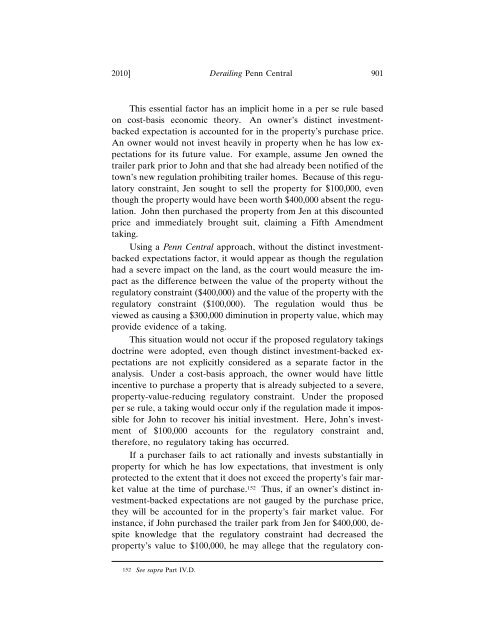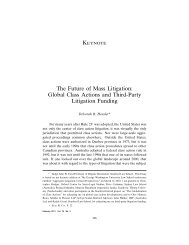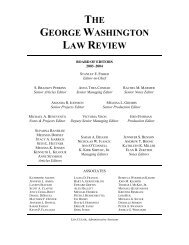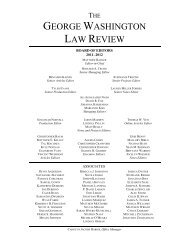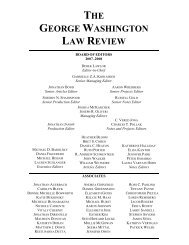View PDF - The George Washington Law Review
View PDF - The George Washington Law Review
View PDF - The George Washington Law Review
Create successful ePaper yourself
Turn your PDF publications into a flip-book with our unique Google optimized e-Paper software.
2010] Derailing Penn Central 901<br />
This essential factor has an implicit home in a per se rule based<br />
on cost-basis economic theory. An owner’s distinct investmentbacked<br />
expectation is accounted for in the property’s purchase price.<br />
An owner would not invest heavily in property when he has low expectations<br />
for its future value. For example, assume Jen owned the<br />
trailer park prior to John and that she had already been notified of the<br />
town’s new regulation prohibiting trailer homes. Because of this regulatory<br />
constraint, Jen sought to sell the property for $100,000, even<br />
though the property would have been worth $400,000 absent the regulation.<br />
John then purchased the property from Jen at this discounted<br />
price and immediately brought suit, claiming a Fifth Amendment<br />
taking.<br />
Using a Penn Central approach, without the distinct investmentbacked<br />
expectations factor, it would appear as though the regulation<br />
had a severe impact on the land, as the court would measure the impact<br />
as the difference between the value of the property without the<br />
regulatory constraint ($400,000) and the value of the property with the<br />
regulatory constraint ($100,000). <strong>The</strong> regulation would thus be<br />
viewed as causing a $300,000 diminution in property value, which may<br />
provide evidence of a taking.<br />
This situation would not occur if the proposed regulatory takings<br />
doctrine were adopted, even though distinct investment-backed expectations<br />
are not explicitly considered as a separate factor in the<br />
analysis. Under a cost-basis approach, the owner would have little<br />
incentive to purchase a property that is already subjected to a severe,<br />
property-value-reducing regulatory constraint. Under the proposed<br />
per se rule, a taking would occur only if the regulation made it impossible<br />
for John to recover his initial investment. Here, John’s investment<br />
of $100,000 accounts for the regulatory constraint and,<br />
therefore, no regulatory taking has occurred.<br />
If a purchaser fails to act rationally and invests substantially in<br />
property for which he has low expectations, that investment is only<br />
protected to the extent that it does not exceed the property’s fair market<br />
value at the time of purchase. 152 Thus, if an owner’s distinct investment-backed<br />
expectations are not gauged by the purchase price,<br />
they will be accounted for in the property’s fair market value. For<br />
instance, if John purchased the trailer park from Jen for $400,000, despite<br />
knowledge that the regulatory constraint had decreased the<br />
property’s value to $100,000, he may allege that the regulatory con-<br />
152 See supra Part IV.D.


